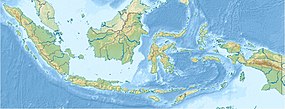Madiun River
 From Wikipedia - Reading time: 7 min
From Wikipedia - Reading time: 7 min
| Madiun River Kali Bengawan Madioen, Kali Madioen | |
|---|---|
| Native name |
|
| Location | |
| Country | Indonesia |
| State | Jawa Timur |
| City | Madiun |
| Physical characteristics | |
| Source confluence | Some tributaries |
| • location | Ponorogo |
| Mouth | Solo River |
• location | Ngawi (town) |
• coordinates | 7°23′17″S 111°27′28″E / 7.38796°S 111.45765°E |
The Madiun River (Indonesian: Bengawan Madiun or Kali Madiun) is a river in East Java, Indonesia, about 500 km to the east of the capital Jakarta.[1] It is the largest tributary of the Solo River.[2] Its name indicates that it passes through the major city of Madiun, East Java, Indonesia.[3] This river starts as several smaller tributaries converging near the city of Ponorogo, in particular the Kali Slahung, Kali Keyang, and Kali Sungkur.[4] It eventually converges with the Solo River near the city of Ngawi.[5]
Historical note
[edit]In 1825, the Dutch East Indies soldiers built a fortress near the convergence of the Madiun and Solo rivers, to fight a local rebellion led by Diponegoro. The fortress was named Fort Van Den Bosch;[2] known locally as Benteng Pendem Ngawi.[6]
Geography
[edit]The river flows entirely within the Province of East Java, passing through Ponorogo Regency, Madiun Regency, City of Madiun, Magetan Regency, and Ngawi Regency, with a savanna climate.[7] The annual average temperature in the area is 26 °C. The warmest month is October when the average temperature is around 30 °C, and the coldest is January, at 24 °C.[8] The wettest month is March, with an average of 546 mm of rainfall, and the driest is September, with 21 mm of rainfall.[9]
For ages, the Madiun River has notoriously caused flooding during the rainy season.[10] Every year the seasonal deluge submerges many fields and houses along the river banks, including some districts in Ponorogo Regency in the upper reaches[4] and in the Ngawi Regency in the lower reaches.[11][12][13] The high debit of water overflows to the Solo River, adding to the regular flooding in Bojonegoro Regency.[14] During the dry season, the river becomes a tourist place for fishing or a place to mine sands for local people.[15]
Tourism
[edit]- Wana Wisata Grape at the Catur river (Grape river).[16]
See also
[edit]References
[edit]- ^ Rand McNally, The New International Atlas, 1993.
- ^ a b Kali Madiun at Geonames.org (cc-by); Mail updated 2012-01-17; Database dump downloaded 2015-11-27
- ^ Kali Madiun: Indonesia - National Geospatial-Intelligence Agency, Bethesda, MD, USA.
- ^ a b Tamtomo, Muslimin (2014) Spatial Planning for Flood Management in Ponorogo Retention Area. Graduate School Gadjah Mada University, Yogyakarta.
- ^ Prawirodiharjo, S (1987). Alam Sekitar Lingkungan Hidup Manusia. PT Balai Pustaka (Persero). p. 13.
- ^ Ekspedisi bengawan Solo: laporan jurnalistik Kompas : kehancuran peradaban sungai besar (in Indonesian). Penerbit Buku Kompas. 2008. ISBN 9789797093907. p. 45
- ^ Peel, M C; Finlayson, B L; McMahon, T A (2007). "Updated world map of the Köppen-Geiger climate classification". Hydrology and Earth System Sciences. 11 (5): 1633–1644. doi:10.5194/hess-11-1633-2007.
- ^ "NASA Earth Observations Data Set Index". NASA. 30 January 2016.
- ^ "NASA Earth Observations: Rainfall (1 month - TRMM)". NASA/Tropical Rainfall Monitoring Mission. 30 January 2016.
- ^ Junghuhn, Franz Wilhelm; Hasskarl, Justus Karl (1854). Java, seine Gestalt, Pflanzendecke und innere Bauart, Volume 2 (in German). Arnold. pp. 331, 363.
- ^ (in Indonesian) Bengawan Madiun Meluap - Pojokpitu, Ngawi. 18 Januari 2017.
- ^ (in Indonesian) Dua Kecamatan di Ngawi Terendam Luapan Air Bengawan Madiun - Bangsa Online, 02 Maret 2017.
- ^ (in Indonesian) Sungai Bengawan Madiun Meluap, Jalan Kwadungan-Kendung Terputus - Kompas, 24 April 2017.
- ^ (in Indonesian) Hilir Jatim Masuk Siaga Banjir Bengawan Solo - Madiun Raya, 16 Februari 2017.
- ^ (in Indonesian) Bikin Heboh! Warga Patihan Temukan Jenglot di Bengawan Madiun - Madiun Pos, 13 Januari 2016.
- ^ (in Indonesian) Madiun Mengaku Tak Tahu Soal Izin Wana Wisata Berita Madiun Grape - Tribun News, 11 April 2017.
External links
[edit]- Wiratmoko, Y.P.B (2005). Cerita rakyat dari Madiun (Jawa Timur). Seri pendidikan budaya. Grasindo. ISBN 9789797329815. p. 13. Using Madiun River as background.
- Direktorat Reboisasi dan Rehabilitasi Indonesia (1972). Monografi fisis daerah aliran Sungai Kali Madiun.
 KSF
KSF
